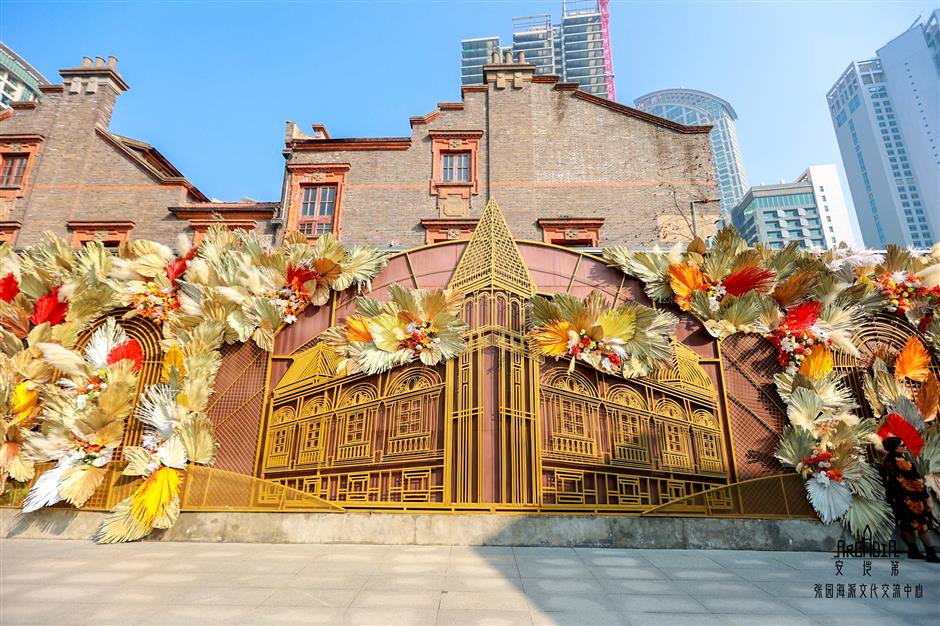Shanghai-style culture center opens in revival of historic Zhangyuan

"Arcadia Lab" Haipai Culture Exchange Center is officially opened this month at Zhangyuan.
A haipai, or Shanghai-style, culture center has been unveiled at historic Zhangyuan as a highlight of a series of events to celebrate the first anniversary of its rebirth.
Zhangyuan, or Zhang's Garden, earned its name after Wuxi business tycoon Zhang Shuhe, also known as Chang Su-ho, bought the property and opened it to the public in 1885 as China's first modern pleasure garden.
With a copious supply of novelties on offer, including a roller coaster, bike racing and movie screenings, it soon rose to become a popular rendezvous. With the completion of the city's tallest Western-style building – Arcadia Hall – in 1893, the garden ushered in its heyday which lasted to the early 1900s.
After Zhang died in 1919, his dream park died with him. The garden area was subdivided and sold to 28 developers.
Though Arcadia Hall, the garden's signature building, was pulled down, most of the buildings survived the wrecking ball, making Zhangyuan one of Shanghai's best-preserved and most diverse shikumen, or stone-gate, compounds.
Over the years, the stately residences were partitioned into smaller units occupied by multiple families, which led to squalid living conditions, with shared kitchens and toilets, and cracked walls and leaky ceilings.
Jing'an launched an urban renewal plan for Zhangyuan in 2018, and started relocations and renovations the following year.
In November 2022, Zhangyuan opened its western section as a site of fashion, culture and commerce, with historic buildings converted to boutique stores and pop-up displays of well-established luxury brands including Dior, Louis Vuitton and Vacheron Constantin as well as Instagrammable stores such as Blue Bottle Coffee, By Far and RE Bike Museum.
Currently, it has 14 renowned international brands. Three of the world's biggest fashion conglomerates – LVMH, Richemont and Kering – have stolen a march on their rivals in securing vantage storefronts in the redevelopment. They are promising displays of luxury goods never before seen on domestic Chinese shelves.
As a highlight of an array of its first anniversary celebrations, the "Arcadia Lab" Haipai Culture Exchange Center officially opened early this month.
Arcadia Hall represented the culmination of Zhangyuan, and its name was adopted to recreate the earlier glamour, according to the Jing'an Real Estate Group, which operates Zhangyuan.
The center, in the No. 8 Building, showcases Zhangyuan's past and future blueprint, and displays works of Shanghai celebrities such as painter Tang Yun, educator Huang Yanpei and actor Zhao Dan.
A series of creative products embedded with Zhangyuan elements was also unveiled, and cultural activities such as exhibitions, salons and performances will be staged at the center regularly.
At the center's launch ceremony, the Jing'an Real Estate Group signed a strategic cooperation with the Shanghai Museum and Shanghai Dongfang Newspaper Co, naming them as the first "culture partners" of Zhangyuan. More partners are welcome.
Meanwhile, a roundtable discussion on Zhangyuan's renovation and a seminar on the repair of historic buildings was held.
Xiang Yihai, deputy director of the Shanghai Administration of Cultural Heritage; Zheng Shiling, a member of the Chinese Academy of Sciences and a professor at Tongji University; Shen Xiaoming, an architect who was responsible for Zhangyuan's renovation; and other experts took part in the discussions.
Xiang hailed Zhangyuan's renovation as an exemplary model of urban renewal.
Zheng said the best way to protect a city's cultural roots is to seek innovation in inheritance, and Zhangyuan presents an example of how to give a new lease of life to heritage.
Another highlight during the anniversary was the "Root and Leaves Fashion and Culture Week," co-held with WWD.
A fashion show by Chinese young designers was presented on Maoming Road N., a narrow alleyway in the middle of Zhangyuan and Fengshengli – both shikumen-style commercial and cultural landmarks.
Themed "She Power," the show reproduced the grand occasion of the women's conference held in Zhangyuan in 1897 for women's rights.
The week also featured an exhibition which explored the roots of global fashion culture.
Currently, the highly-anticipated eastern section is still under renovation.
It is set to be completed in 2026, featuring an art museum designed by renown Japanese architect Kengo Kuma, and a boutique hotel renovated from a masterpiece by famed architect Laszlo Hudec – the former site of Gonghui Hospital – in addition to residences, offices and commercial complexes.
















